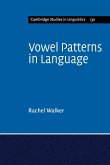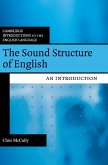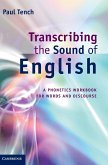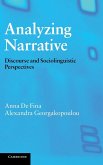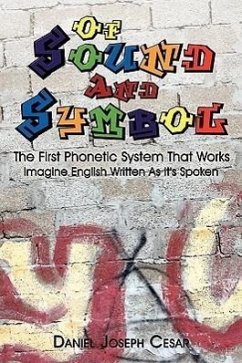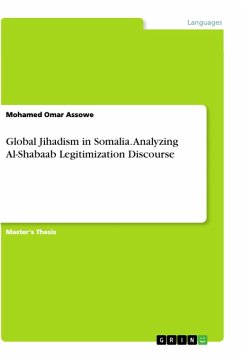- Gebundenes Buch
- Merkliste
- Auf die Merkliste
- Bewerten Bewerten
- Teilen
- Produkt teilen
- Produkterinnerung
- Produkterinnerung
This textbook shows students how to analyze phonological problems with a focus on practical tools, methodology and step-by-step instructions.
Andere Kunden interessierten sich auch für
![Vowel Patterns in Language Vowel Patterns in Language]() Rachel WalkerVowel Patterns in Language128,99 €
Rachel WalkerVowel Patterns in Language128,99 €![Vowel Patterns in Language Vowel Patterns in Language]() Rachel WalkerVowel Patterns in Language54,99 €
Rachel WalkerVowel Patterns in Language54,99 €![The Sound Structure of English The Sound Structure of English]() Chris MccullyThe Sound Structure of English143,99 €
Chris MccullyThe Sound Structure of English143,99 €![Transcribing the Sound of English Transcribing the Sound of English]() Paul TenchTranscribing the Sound of English114,99 €
Paul TenchTranscribing the Sound of English114,99 €![Analyzing Narrative Analyzing Narrative]() Anna De FinaAnalyzing Narrative112,99 €
Anna De FinaAnalyzing Narrative112,99 €![Of Sound and Symbol Of Sound and Symbol]() Daniel Joseph CesarOf Sound and Symbol46,99 €
Daniel Joseph CesarOf Sound and Symbol46,99 €![Global Jihadism in Somalia. Analyzing Al-Shabaab Legitimization Discourse Global Jihadism in Somalia. Analyzing Al-Shabaab Legitimization Discourse]() Mohamed Omar AssoweGlobal Jihadism in Somalia. Analyzing Al-Shabaab Legitimization Discourse47,95 €
Mohamed Omar AssoweGlobal Jihadism in Somalia. Analyzing Al-Shabaab Legitimization Discourse47,95 €-
-
-
This textbook shows students how to analyze phonological problems with a focus on practical tools, methodology and step-by-step instructions.
Hinweis: Dieser Artikel kann nur an eine deutsche Lieferadresse ausgeliefert werden.
Hinweis: Dieser Artikel kann nur an eine deutsche Lieferadresse ausgeliefert werden.
Produktdetails
- Produktdetails
- Verlag: Cambridge University Press
- Seitenzahl: 588
- Erscheinungstermin: 6. November 2013
- Englisch
- Abmessung: 250mm x 175mm x 36mm
- Gewicht: 1180g
- ISBN-13: 9780521195799
- ISBN-10: 0521195799
- Artikelnr.: 39294030
- Herstellerkennzeichnung
- Produktsicherheitsverantwortliche/r
- Europaallee 1
- 36244 Bad Hersfeld
- gpsr@libri.de
- Verlag: Cambridge University Press
- Seitenzahl: 588
- Erscheinungstermin: 6. November 2013
- Englisch
- Abmessung: 250mm x 175mm x 36mm
- Gewicht: 1180g
- ISBN-13: 9780521195799
- ISBN-10: 0521195799
- Artikelnr.: 39294030
- Herstellerkennzeichnung
- Produktsicherheitsverantwortliche/r
- Europaallee 1
- 36244 Bad Hersfeld
- gpsr@libri.de
Introduction
Part I. Distribution: 1. Patterns of sounds: vowel co-occurrence in Kikuyu
2. The distribution of English nasals
3. Luganda liquids and the analysis of complementary distribution
4. Contrast and complementarity: multiple complementation in Thai
Part II. Alternation: 5. Alternation and the case of English nasals
6. Tibetan numerals and underlying representation
7. Tonkawa stem alternation
8. Yawelmani and interacting processes
Part III. Syllable: 9. The distribution of syllable in Ponapean
10. Syllable and vowel epenthesis in Ponapean
11. Ponapean syllable and vowel epenthesis
an optimal-theoretic analysis
12. Syllable and segmental processes in Diola-Fogny
Part IV. Tone: 13. Tonal distribution in Mende and autosegmental representation
14. Tonal alternation in Mende
15. Yoruba tone asymmetry and derivational accounts of asymmetry
16. Yoruba tone asymmetry and optimality theory
Part V. Stress: 17. Pintupi, Wargamay and Choctaw stress and metrical theory
18. Pintupi, Wargamay and Choctaw stress and optimality theory
19. To stress or not to stress: stress-epenthesis interactions in Yimas
Part VI. Prosodic Morphology: 20. Templatic morphology and Arabic broken plurals
21. The emergence of the unmarked and Swati verb reduplication
22. Prosodic misalignment: LuGanda glide epenthesis.and Swati reduplication
Appendix A. Sample instructions for the reading response assignment
Appendix B. Sample instructions for a problem: vowel co-occurrence in Kikuyu bi-syllabic roots and root-suffix forms
Index of constraints and rules
Language index
Subject Index.
Part I. Distribution: 1. Patterns of sounds: vowel co-occurrence in Kikuyu
2. The distribution of English nasals
3. Luganda liquids and the analysis of complementary distribution
4. Contrast and complementarity: multiple complementation in Thai
Part II. Alternation: 5. Alternation and the case of English nasals
6. Tibetan numerals and underlying representation
7. Tonkawa stem alternation
8. Yawelmani and interacting processes
Part III. Syllable: 9. The distribution of syllable in Ponapean
10. Syllable and vowel epenthesis in Ponapean
11. Ponapean syllable and vowel epenthesis
an optimal-theoretic analysis
12. Syllable and segmental processes in Diola-Fogny
Part IV. Tone: 13. Tonal distribution in Mende and autosegmental representation
14. Tonal alternation in Mende
15. Yoruba tone asymmetry and derivational accounts of asymmetry
16. Yoruba tone asymmetry and optimality theory
Part V. Stress: 17. Pintupi, Wargamay and Choctaw stress and metrical theory
18. Pintupi, Wargamay and Choctaw stress and optimality theory
19. To stress or not to stress: stress-epenthesis interactions in Yimas
Part VI. Prosodic Morphology: 20. Templatic morphology and Arabic broken plurals
21. The emergence of the unmarked and Swati verb reduplication
22. Prosodic misalignment: LuGanda glide epenthesis.and Swati reduplication
Appendix A. Sample instructions for the reading response assignment
Appendix B. Sample instructions for a problem: vowel co-occurrence in Kikuyu bi-syllabic roots and root-suffix forms
Index of constraints and rules
Language index
Subject Index.
Introduction
Part I. Distribution: 1. Patterns of sounds: vowel co-occurrence in Kikuyu
2. The distribution of English nasals
3. Luganda liquids and the analysis of complementary distribution
4. Contrast and complementarity: multiple complementation in Thai
Part II. Alternation: 5. Alternation and the case of English nasals
6. Tibetan numerals and underlying representation
7. Tonkawa stem alternation
8. Yawelmani and interacting processes
Part III. Syllable: 9. The distribution of syllable in Ponapean
10. Syllable and vowel epenthesis in Ponapean
11. Ponapean syllable and vowel epenthesis
an optimal-theoretic analysis
12. Syllable and segmental processes in Diola-Fogny
Part IV. Tone: 13. Tonal distribution in Mende and autosegmental representation
14. Tonal alternation in Mende
15. Yoruba tone asymmetry and derivational accounts of asymmetry
16. Yoruba tone asymmetry and optimality theory
Part V. Stress: 17. Pintupi, Wargamay and Choctaw stress and metrical theory
18. Pintupi, Wargamay and Choctaw stress and optimality theory
19. To stress or not to stress: stress-epenthesis interactions in Yimas
Part VI. Prosodic Morphology: 20. Templatic morphology and Arabic broken plurals
21. The emergence of the unmarked and Swati verb reduplication
22. Prosodic misalignment: LuGanda glide epenthesis.and Swati reduplication
Appendix A. Sample instructions for the reading response assignment
Appendix B. Sample instructions for a problem: vowel co-occurrence in Kikuyu bi-syllabic roots and root-suffix forms
Index of constraints and rules
Language index
Subject Index.
Part I. Distribution: 1. Patterns of sounds: vowel co-occurrence in Kikuyu
2. The distribution of English nasals
3. Luganda liquids and the analysis of complementary distribution
4. Contrast and complementarity: multiple complementation in Thai
Part II. Alternation: 5. Alternation and the case of English nasals
6. Tibetan numerals and underlying representation
7. Tonkawa stem alternation
8. Yawelmani and interacting processes
Part III. Syllable: 9. The distribution of syllable in Ponapean
10. Syllable and vowel epenthesis in Ponapean
11. Ponapean syllable and vowel epenthesis
an optimal-theoretic analysis
12. Syllable and segmental processes in Diola-Fogny
Part IV. Tone: 13. Tonal distribution in Mende and autosegmental representation
14. Tonal alternation in Mende
15. Yoruba tone asymmetry and derivational accounts of asymmetry
16. Yoruba tone asymmetry and optimality theory
Part V. Stress: 17. Pintupi, Wargamay and Choctaw stress and metrical theory
18. Pintupi, Wargamay and Choctaw stress and optimality theory
19. To stress or not to stress: stress-epenthesis interactions in Yimas
Part VI. Prosodic Morphology: 20. Templatic morphology and Arabic broken plurals
21. The emergence of the unmarked and Swati verb reduplication
22. Prosodic misalignment: LuGanda glide epenthesis.and Swati reduplication
Appendix A. Sample instructions for the reading response assignment
Appendix B. Sample instructions for a problem: vowel co-occurrence in Kikuyu bi-syllabic roots and root-suffix forms
Index of constraints and rules
Language index
Subject Index.



